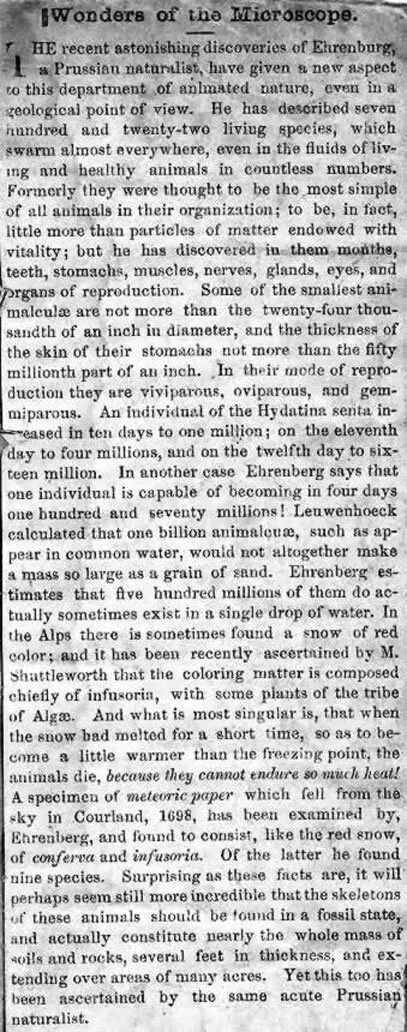Wonders of the Microscope
The recent astonishing discoveries of Ehrenberg, a Prussian naturalist, have given a new aspect to this department of animated nature, even in a geological point of view. He has described seven hundred and twenty-two living species, which swarm almost everywhere, even in the fluids of living and healthy animals in countless numbers. Formerly they were thought to be the most simple of all animals in their organization; to be, in fact, little more than particles of matter endowed with vitality; but he has discovered in them mouths, teeth, stomachs, muscles, nerves, glands, eyes, and organs of reproduction. Some of the smallest animalculae are not more than the twenty-four thousandth of an inch in diameter, and the thickness of the skin of their stomachs not more than the fifty millionth part of an inch. In their mode of reproduction they are viviparous, oviparous, and gemmiparous. An individual of the Hydatina senta increased in ten days to one million; on the eleventh day to four millions, and on the twelfth day to sixteen million. In another case Ehrenberg says that one individual is capable of becoming in four days one hundred and seventy millions! Leuwenhoeck calculated that one billion animalcuae, such as appear in common water, would not altogether make a mass so large as a grain of sand. Ehrenberg estimates that five hundred millions of them do actually sometimes exist in a single drop of water. In the Alps there is sometimes found a snow of red color; and it has been recently ascertained by M. Shuttleworth that the coloring matter is composed chiefly of infusoria, with some plants of the tribe of Algae. And what is most singular is, that when the snow had melted for a short time, so as to become a little warmer than the freezing point, the animals die, because they cannot endure so much heat! A specimen of meteoric paper which fell from the sky in Courland, 1698, has been examined by, Ehrenberg, and found to consist, like the red snow, of conferva and infusoria. Of the latter he found nine species. Surprising as these facts are, it will perhaps seem still more incredible that the skeletons of these animals should be found in a fossil state, and actually constitute nearly the whole mass of soils and rocks, several feet in thickness, and extending over areas of many acres. Yet this too has been ascertained by the same acute Prussian naturalist.

